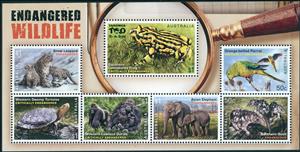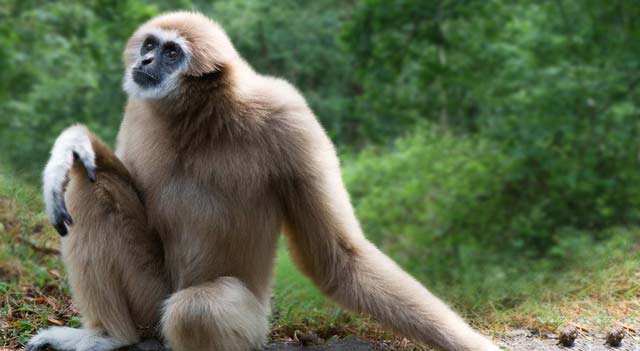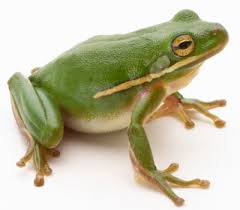Souvenir Sheet: Endangered Wildlife Souvenir Sheet (Australia 2016)
Endangered Wildlife Souvenir Sheet (Australia 2016)
20 September (Australia ) within release Endangered Wildlife goes into circulation Souvenir Sheet Endangered Wildlife Souvenir Sheet face value 6 Australian dollar
| Souvenir Sheet Endangered Wildlife Souvenir Sheet in catalogues | |
|---|---|
| Colnect codes: | Col:AU 2016-91 |
Souvenir Sheet is horizontal format.
Also in the issue Endangered Wildlife:
- Souvenir Sheet - Endangered Wildlife Souvenir Sheet face value 6;
- Stamp - Southern Corroboree Frog (Pseudophryne corroboree) face value 1;
- Stamp - Snow Leopard (Panthera uncia syn. Uncia uncia) face value 1;
- Stamp - Snow Leopard (Panthera uncia syn. Uncia uncia) face value 1;
- Stamp - Asian Elephant (Elephas maximus) face value 1;
- Stamp - Asian Elephant (Elephas maximus) face value 1;
- Stamp - Western Lowland Gorilla (Gorilla gorilla gorilla) face value 1;
- Stamp - Western Lowland Gorilla (Gorilla gorilla gorilla) face value 1;
- Stamp - Western Swamp Tortoise (Pseudemydura umbrina) face value 1;
- Stamp - Western Swamp Tortoise (Pseudemydura umbrina) face value 1;
- Stamp - Orange-bellied Parrot (Neophema chrysogaster) face value 50;
- Stamp - Northern Quoll (Dasyurus hallucatus) face value 50;
- Se-tenant - Endangered Wildlife face value 4*1;
- Se-tenant - Endangered Wildlife face value 2*50;
- Booklet - Endangered Wildlife face value 20*1;
- Stamp - Asian Elephant (Elephas maximus) face value 1;
- Stamp - Western Lowland Gorilla (Gorilla gorilla gorilla) face value 1;
- Stamp - Snow Leopard (Panthera uncia syn. Uncia uncia) face value 1;
- Stamp - Western Swamp Tortoise (Pseudemydura umbrina) face value 1;
Souvenir Sheet Endangered Wildlife Souvenir Sheet it reflects the thematic directions:
Amphibians are ectothermic, anamniotic, four-limbed vertebrate animals that constitute the class Amphibia. In its broadest sense, it is a paraphyletic group encompassing all tetrapods, excluding the amniotes (tetrapods with an amniotic membrane, such as modern reptiles, birds, and mammals). All extant (living) amphibians belong to the monophyletic subclass Lissamphibia, with three living orders: Anura (frogs), Urodela (salamanders), and Gymnophiona (caecilians). Evolved to be mostly semiaquatic, amphibians have adapted to inhabit a wide variety of habitats, with most species living in freshwater, wetland or terrestrial ecosystems (such as riparian woodland, fossorial and even arboreal habitats). Their life cycle typically starts out as aquatic larvae with gills known as tadpoles, but some species have developed behavioural adaptations to bypass this.
Animals are multicellular, eukaryotic organisms of the kingdom Animalia (also called Metazoa). All animals are motile, meaning they can move spontaneously and independently, at some point in their lives. Their body plan eventually becomes fixed as they develop, although some undergo a process of metamorphosis later on in their lives. All animals are heterotrophs: they must ingest other organisms or their products for sustenance.
Apes (collectively Hominoidea /hɒmɪˈnɔɪdi.ə/) are a clade of Old World simians native to sub-Saharan Africa and Southeast Asia (though they were more widespread in Africa, most of Asia, and Europe in prehistory), which together with its sister group Cercopithecidae form the catarrhine clade, cladistically making them monkeys. Apes do not have tails due to a mutation of the TBXT gene. In traditional and non-scientific use, the term ape can include tailless primates taxonomically considered Cercopithecidae (such as the Barbary ape and black ape), and is thus not equivalent to the scientific taxon Hominoidea. There are two extant branches of the superfamily Hominoidea: the gibbons, or lesser apes; and the hominids, or great apes.
Birds (Aves), a subgroup of Reptiles, are the last living examples of Dinosaurs. They are a group of endothermic vertebrates, characterised by feathers, toothless beaked jaws, the laying of hard-shelled eggs, a high metabolic rate, a four-chambered heart, and a strong yet lightweight skeleton. Birds live worldwide and range in size from the 5 cm (2 in) bee hummingbird to the 2.75 m (9 ft) ostrich. They rank as the class of tetrapods with the most living species, at approximately ten thousand, with more than half of these being passerines, sometimes known as perching birds. Birds are the closest living relatives of crocodilians.
Elephants are the largest living land animals. Three living species are currently recognised: the African bush elephant (Loxodonta africana), the African forest elephant (L. cyclotis), and the Asian elephant (Elephas maximus). They are the only surviving members of the family Elephantidae and the order Proboscidea; extinct relatives include mammoths and mastodons.
A frog is any member of a diverse and largely carnivorous group of short-bodied, tailless amphibians composing the order Anura[(coming from the Ancient Greek ἀνούρα, literally 'without tail'). The oldest fossil "proto-frog" Triadobatrachus is known from the Early Triassic of Madagascar (250 million years ago), but molecular clock dating suggests their split from other amphibians may extend further back to the Permian, 265 million years ago. Frogs are widely distributed, ranging from the tropics to subarctic regions, but the greatest concentration of species diversity is in tropical rainforest. Frogs account for around 88% of extant amphibian species. They are also one of the five most diverse vertebrate orders. Warty frog species tend to be called toads, but the distinction between frogs and toads is informal, not from taxonomy or evolutionary history.
Mammals are any vertebrates within the class Mammalia (/məˈmeɪli.ə/ from Latin mamma "breast"), a clade of endothermic amniotes distinguished from reptiles (including birds) by the possession of a neocortex (a region of the brain), hair, three middle ear bones and mammary glands. All female mammals nurse their young with milk, secreted from the mammary glands. Mammals include the largest animals on the planet, the great whales. The basic body type is a terrestrial quadruped, but some mammals are adapted for life at sea, in the air, in trees, underground or on two legs. The largest group of mammals, the placentals, have a placenta, which enables the feeding of the fetus during gestation. Mammals range in size from the 30–40 mm (1.2–1.6 in) bumblebee bat to the 30-meter (98 ft) blue whale. With the exception of the five species of monotreme (egg-laying mammals), all modern mammals give birth to live young. Most mammals, including the six most species-rich orders, belong to the placental group. The largest orders are the rodents, bats and Soricomorpha (shrews and allies). The next three biggest orders, depending on the biological classification scheme used, are the Primates (apes and monkeys), the Cetartiodactyla (whales and even-toed ungulates), and the Carnivora (cats, dogs, seals, and allies).







